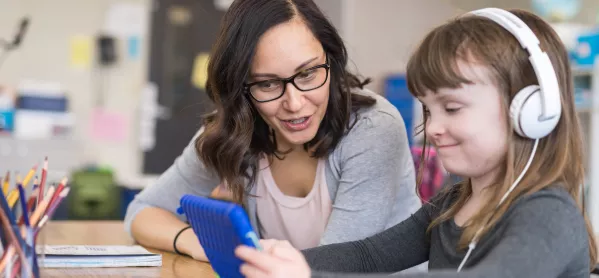Why international schools embrace personalised learning

A few years ago, a family joined our school community. They had moved from Italy to Kuala Lumpur and enrolled their three-year-old son into our early years foundation stage.
It didn’t take long before the class teacher became concerned. This child was clearly disengaged from their learning, wouldn’t communicate with adults, despite being able to speak English, and was beginning to show signs of anxiety.
Read more: The personal cost of teaching abroad
From the magazine: How to recruit a more diverse leadership team
Listen: What age should children start school?
What his class teacher did next was remarkable. She quickly adapted the learning environment within her classroom to reflect elements of his culture. With help from his parents, she invested time in really getting to know his interests.
In free-flow activities, she provided opportunities for the whole class to experience Italian culture and cuisine, expertly using these learning experiences to support and deepen the early learning goals for all of the children in her class.
Within a short time, this child became engaged, started to develop friendships and became visibly more comfortable and happy in his new environment. It turned out that he loved to cook with his chef dad and had already decided that he wanted to own a restaurant when he grew up. Brilliant!
For me, this is what personalised learning is all about, and it is especially relevant in the international school context.

Getting to know you
As educators, we are so often exposed to a range of educational jargon that can be ambiguous or confusing because the language used is synonymous with other terms and phrases.
Personalised learning is often confused with “individualised” or “differentiated” learning. But personalising learning isn’t so much about setting individual targets or modifying pace to suit individual needs.
Rather, personalised learning is about really knowing the children you work with on a day-to-day basis. It’s about understanding their backgrounds, and recognising their passions and interests - and using these as kindling to ignite the desire to learn.
Equally important is taking the time to explore the context in which a teacher’s school is set - its parent demographic and the external agencies with which it has potential links. These links can provide a rich bed of opportunities for pupils to explore.
The foundation stage teacher I referred to above is genuinely interested in her pupils. When she teaches, she is in her element. She views the process of teaching and learning not through a set of curriculum objectives or standards that must be met but through the eyes of the children who enter her classroom each day.
As part of her practice, she goes to great lengths to make her lessons meaningful, purposeful and reflective of the interests and experiences of her children, while still managing to adhere to policy and provide rigorous learning experiences.
Embrace diversity, harness creativity
International school teachers and leaders are in the privileged position of welcoming children from a wide variety of backgrounds and cultures.
I do sometimes worry that we miss important opportunities to explore ways in which the curriculum or day-to-day delivery of lessons can harness the passion, creativity and interests of our pupils. I worry that many of our schools still promote the message that disciplines such as maths and science hold more value than, say, drama or music.
In his TED talks and educational literature, Sir Ken Robinson often tells stories of well-known people who felt they were marginalised by education systems that upheld those values as truths. Mick Fleetwood, the drummer from Fleetwood Mac, and Gillian Lynne, the inspirational choreographer of shows such as Cats, have told of dark times at school.
Robinson suggests that what is needed is for our education system to transform and evolve. He uses the analogy of an agricultural system in which teachers, like farmers, can create the conditions for learning to flourish. And he warns against the current standardised mechanical system which leads to some young people leaving school and ending up in careers that don’t personally fulfil them.
Of course, it does all sound idealistic. Many teachers would argue that factors such as policy, timetabling, intervention groups and the pressures around pupil progress and data provide too many barriers to overcome.
They may feel that what is needed is not so much evolution but a revolution. But surely, wouldn’t it take just tweak of mindset? Does it have to be complex?
Passion projects
In the foundation stage in my current school, teaching through the passions of children is an everyday occurrence. Planning is regularly adapted to change course with what the children are interested in and use the medium of subjects like performance arts to allow them explore learning in emotive and physical ways.
If a group of children have been identified as having a love for singing, lessons such as maths, phonics or science might be delivered through song. I have witnessed some highly skilled Year 6 teachers harness the genius of the rapper Stormzy when building knowledge during a science lesson.
I don’t believe in a revolutionary approach. International schools don’t need to drastically change their curriculum, restructure timetables or throw away policies. I think personalised learning can exist quite happily within these structures, and even thrive.
International school leaders must play their role in this agricultural analogy. They, too, have a responsibility to create the conditions in which teachers have the agency to go off road. And they must encourage wiggle room in policies to allow educators to react to their students’ needs.
Don’t be fooled into thinking that this dumbs down learning. On the contrary, I am convinced that learning through passion provides rigour and will raise outcomes. In addition, it inspires the independent pursuit of further learning and conveys to the child the important message that we value their dreams.
Robinson ends one of his TED talks by reading the WB Yeats poem He Wishes for the Cloths of Heaven. He uses it to illustrate a simple truth: that each and every day, children enter schools across the world and lay out their dreams at our feet.
It is our responsibility as educators to handle those dreams with the utmost care.
Paul Dowlman is assistant head at Victory Heights Primary School, Dubai

